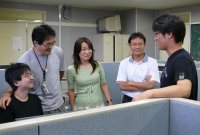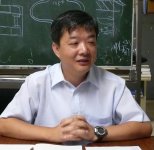 |
 |
|||||||||||||
|
|||||||||||||
|
|||||||||||||
|
Every month, a lot of Asian researchers come to KEK to conduct their research or experiments. “We have had 45 visitors for fiscal year 2007 so far, including ten Korean researchers,” says Tomiko Shirakata, secretary at KEK’s Linear Collider Project Office. Shirkata is in charge of KEK’s visitors programme activities and provides all visitor supports such as arranging logistics, dealing with the consulate service for visa applications, and giving tips on how to spend days off in Japan. KEK launched the visitor programme in April 2006 aiming to facilitate the foreign researchers’ activities in Japan, especially for Asian researchers and students, who may have difficulties to conduct research overseas for some country-specific reasons. These days, the visitor's office is quieter than usual, since the Accelerator Test Facility (ATF), usually busy with so many visitors from all over the world, is now in the summer shut-down period. “We have steady number of visitors from Korea though.” says Shirakata. “Right now, five Korean researchers and post-docs are staying at KEK.” Hyoung-suk Kim from the Center for High Energy Physics, Kyungpook National University (KNU), is one of them. “The purpose of my visit to KEK this time is to discuss about a collaboration between Korea and Japan in superconducting cavities and high-power RF source areas in which I have interest. The research facilities for particle physics are on a much smaller scale in Korea. Some kinds of research are thus difficult to conduct in Korea. Using Japanese facilities helps us a lot, and we would like to create a framework which would make Japanese facilities more accessible to Korean researchers,” says Kim. Many Korean researchers have been to Japan several times. Seunghwan Shin, a post-doc from KNU, finished his second visit at the end of May. The purpose of his stay was to examine the design of the beam position monitor under development at KNU, which is similar to a cavity-type beam position monitor (IP-BPM) developed at KEK. In order to measure the beam position stability at the ATF2 final focus, KEK fabricated the first model of IP-BPMs and tested it in the ATF extraction line. At KNU, researchers are trying to make a different design for this. Major modification of the new type will be the time resolution; enabling easier separation of individual bunches in a multi-bunch signal. Since this was the first time that Shin worked on cavity BPMs, he learned the procedure of the design work of the BPM. He also joined the tests of KEK BPM. He then started designing the new BPM, constantly discussing with the KEK group. International collaboration is important for not only research purposes. “If we can take part in future collider programmes such as ILC, Korean researchers will have another valuable chance to bring up research capabilities in high-energy physics and accelerator areas rapidly,” Kim says. At the Lepton-Photon conference to be held at Daegu, Korea, in August, the first ILC publication translated into Korean will be handed out. “We need ILC-related documents translated into Korean to gain understanding from a broader audience including our funding agency. We would like to have more publications in Korean in the near future,” he added. Language represents the culture of a country, and learning other languages will definitely help mutual understanding and may even lead to a better outcome from collaborative research. “I am communicating with Asian visitors in English. I did not experience much problem using English, but I sometimes use written communication since none of us is a native speaker,” says Shirakata. Most of visitors are staying at KEK for a couple of months so KEK is offering free Japanese classes for visitors and their family members, providing minimum and essential information to survive in Japan, including reading, writing kanas (Japanese alphabets), what to do in case of emergencies, and cultural differences you should be aware of. “It is very nice to hear researchers saying 'Konnichiwa ('Hi' in Japanese)' or 'Arigato' ('Thank you') to me after staying here for a while,” says Shirakata. The effort to build the ILC is building mutual understanding among the Asian researchers. -- Rika Takahashi |
|||||||||||||
| © International Linear Collider |

